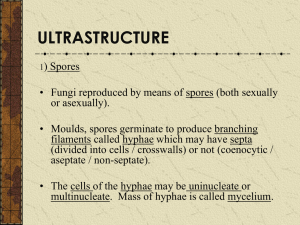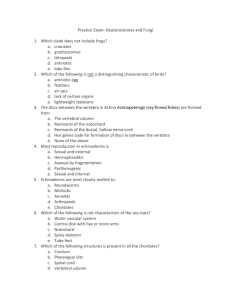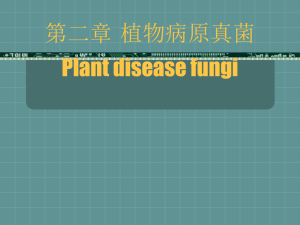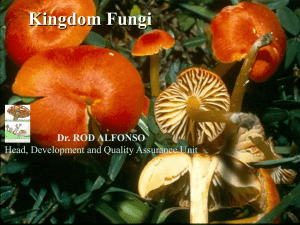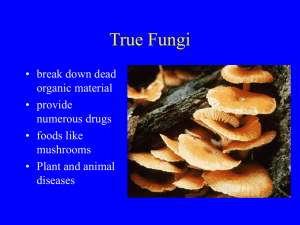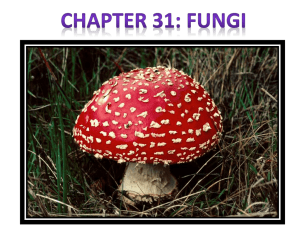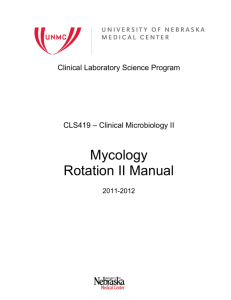Important terms
advertisement
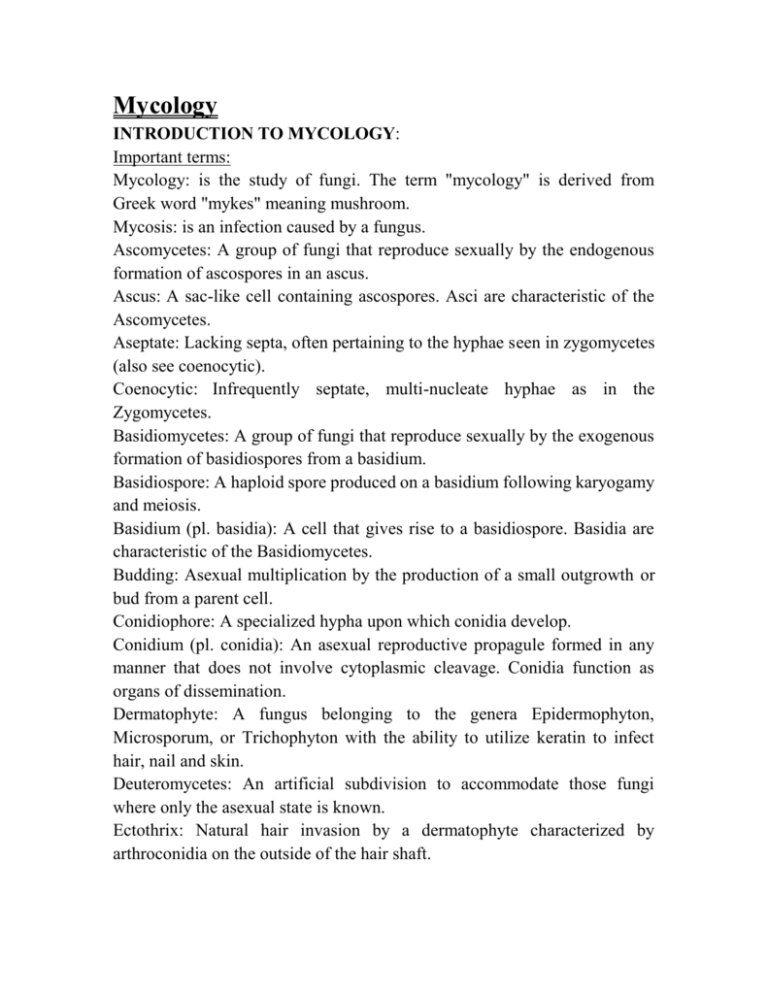
Mycology INTRODUCTION TO MYCOLOGY: Important terms: Mycology: is the study of fungi. The term "mycology" is derived from Greek word "mykes" meaning mushroom. Mycosis: is an infection caused by a fungus. Ascomycetes: A group of fungi that reproduce sexually by the endogenous formation of ascospores in an ascus. Ascus: A sac-like cell containing ascospores. Asci are characteristic of the Ascomycetes. Aseptate: Lacking septa, often pertaining to the hyphae seen in zygomycetes (also see coenocytic). Coenocytic: Infrequently septate, multi-nucleate hyphae as in the Zygomycetes. Basidiomycetes: A group of fungi that reproduce sexually by the exogenous formation of basidiospores from a basidium. Basidiospore: A haploid spore produced on a basidium following karyogamy and meiosis. Basidium (pl. basidia): A cell that gives rise to a basidiospore. Basidia are characteristic of the Basidiomycetes. Budding: Asexual multiplication by the production of a small outgrowth or bud from a parent cell. Conidiophore: A specialized hypha upon which conidia develop. Conidium (pl. conidia): An asexual reproductive propagule formed in any manner that does not involve cytoplasmic cleavage. Conidia function as organs of dissemination. Dermatophyte: A fungus belonging to the genera Epidermophyton, Microsporum, or Trichophyton with the ability to utilize keratin to infect hair, nail and skin. Deuteromycetes: An artificial subdivision to accommodate those fungi where only the asexual state is known. Ectothrix: Natural hair invasion by a dermatophyte characterized by arthroconidia on the outside of the hair shaft. Endothrix: Natural hair invasion by a dermatophyte characterized by the development of arthroconidia within the hair shaft only. Hyphomycetes: A class of mycelial moulds which reproduce asexually by conidia on hyphae or aggregations of hyphae. Mycelium (pl. mycelia): The mass of hyphae making up the thallus of a fungus. Spore: a reproductive propagule formed by either meiosis or mitosis. However, if by asexual means, cleavage of cytoplasm is usually involved. Zygospores: A thick-walled sexual spore formed by the fusion of two similar gametangia; characteristic of the Zygomycetes. General properties of fungi: 1. They are eukaryotic cells contain nuclei, mitochondria, Golgi apparatus, endoplasmic reticulum, lysosomes etc... They also exhibit mitosis. 2. Have an ergosterols in their membranes and possesses 80S ribosomes. 3. Have a rigid cell wall and are therefore non-motile. All fungi possess cell wall made of chitin. 4. Fungi are chemoheterotrophs (require organic compounds for both carbon and energy sources) and fungi lack chlorophyll and are therefore not autotrophic. 5. Fungi are osmiotrophic; they obtain their nutrients by absorption. 6. They obtain nutrients as saprophytes (decaying matter) or as parasites (living matter). 7. All fungi require water and oxygen and there are no obligate anaerobes. 8. Typically reproduce asexually and/or sexually by producing spores. 9. They grow either reproductively by budding or non-reproductively by hyphal tip elongation. 10. Food storage is generally in the form of lipids and glycogen. Morphology of fungi: Fungi exist in two fundamental forms; the filamentous (hyphal) and single celled budding forms (yeast). But, for the classification reasons they are studied as moulds, yeasts, yeast like and dimorphic fungi. All fungi have typical eukaryotic morphology. They have rigid cell wall composed of chitin, which may be layered with mannans, glucans and other polysaccharides in association with polypeptides. Some lower fungi possess cellulose in their cell wall. Some fungi such as Cryptococcus and yeast form of Histoplasma capsulatum possess polysaccharide capsules that help them to evade phagocytosis. Inner to the cell wall is the plasma membrane that is a typical bilayered membrane in addition to the presence of sterols. Fungal membranes possess ergosterol in contrast to cholesterol found in mammalian cells. The cytoplasm consists of various organelles such as mitochondria, golgi apparatus, ribosomes, endoplasmic reticulum, lysosomes, microtubules and a membrane enclosed nucleus. A unique property of nuclear membrane is that it persists throughout the metaphase of mitosis unlike in plant and animal cells where it dissolves and re-forms. Moulds: The thallus of mould is made of hyphae, which are cylindrical tube like structures that elongates by growth at tips. A mass of hyphae is known as mycelium. It is the hyphae that is responsible for the filamentous nature of mould. The hyphae may be branched or unbranched. They may be septate or aseptate. Hyphae usually have cross walls that divide them into numerous cells. These cross walls, called septa have small pores through which cytoplasm is continuous throughout the hyphae. Therefore all hyphal fungi tend to be coenocytic (multinucleate). With exception of zygomycetes (Rhizopus, Mucor), all moulds are septate. Non-septate hyphae are considered to be more primitive because if a hyphal strand is damaged the entire strand dies. When a septate hyphal strand is damaged, the pores between adjacent compartments can be plugged, thus preventing death of the whole hyphal strand. Mycelium are of three kinds: Vegetative mycelium are those that penetrates the surface of the medium and absorbs nutrients. 2. Aerial mycelium are those that grow above the agar surface 3. Fertile mycelium are aerial hyphae that bear reproductive structures such as conidia or sporangia. 1. Yeasts: Yeasts are unicellular spherical to ellipsoid cells. They reproduce by budding, which result in blastospore (blastoconidia) formation. In some cases, as the cells buds the buds fail to detach and elongate thus forming a chain of elongated hyphae like filament called pseudohyphae. This property is seen in Candia albicans. The same species also have the ability to produce true hyphae, which is seen as germ tube. Some yeast such as Cryptococcus and the yeast form of Blastomyces dermatatidis produce polysaccharide capsule. Capsules can be demonstrated by negative staining methods using India ink or Nigrosin. Beneficial Effects of Fungi: 1. Decomposition - nutrient and carbon recycling. 2. Biosynthetic factories. The fermentation property is used for the industrial production of alcohols, citric, oxalic and gluconic acids. 3. Important sources of antibiotics, such as Penicillin. 4. Model organisms for biochemical and genetic studies. Eg: Neurospora crassa 5. Saccharomyces cerviciae is extensively used in recombinant DNA technology, which includes the Hepatitis-B Vaccine. 6. Some fungi are edible (mushrooms). 7. Yeasts provide nutritional supplements such as vitamins and cofactors. 8. Penicillium is used to flavor in some type of cheese. 9. Ergot produced by Claviceps purpurea contains medically important alkaloids that help in inducing uterine contractions, controlling bleeding and treating migraine. Harmful Effects of Fungi: 1. Destruction of food, paper, and cloth. 2. Animal and human diseases, including allergies. 3. Toxins produced by poisonous mushrooms and within food (Mycetism and Mycotoxicosis). 4. Plant diseases. 5. Spoilage of agriculture produces such as vegetables.
![General Mycology [33 slides]](http://s3.studylib.net/store/data/009666096_1-8b8b538a5c288d48feb634b8753cbf86-300x300.png)

